


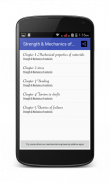
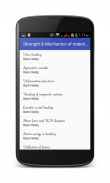
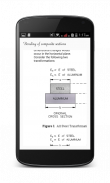
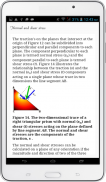

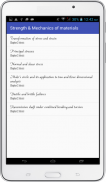
Strength of materials

Mô tả của Strength of materials
Notes,reference,assignments of strength & mechanics of materials for engineering students.It almost contain all topics for strength & mechanics of materials which are given below
Chapter :1
Mechanical properties of materials: Ductility, malleability, hardness, toughness, fatigue, creep; behavior
of materials under tension, compression, bending, shear; ductile and brittle materials, failure of MS and
CI in tension and torsion
Stress and strain: stresses in members of a structure, axial loading, normal stress, shear stress, bearing
stress, analysis of simple structures, stepped rods, members in series and parallel: stress strain diagram,
Hooke’s law, modulus of elasticity, elastic and plastic behavior of materials, deformation under axial
loading, statically indeterminate problems, stress due to temperature, Poisson’s ratio, Bulk modulus, shear
strain, relation among elastic constants, residual stress, fiber reinforced composite materials, strain energy
under axial loads and stresses due to impact of falling weights.
Chapter :2
Transformation of stress and strain, principal stresses, normal and shear stress, Mohr’s circle and its
application to two and three dimensional analysis, ductile and brittle failures, transmission shaft under
combined bending and torsion; stresses in thin walled pressure vessel
Chapter :3
Bending: pure bending, symmetric member, deformation and stress, bending of composite sections,
eccentric axial loading, shear force and BM diagram, relationship among load, shear and BM, shear
stresses in beams, strain energy in bending, deflection of beams, equation of elastic curve, Macaulay’s
method and Area moment method for deflection of beams.
Chapter :4
Torsion in shafts: stresses in a shaft, deformation in circular shaft, angle of twist, stepped-hollow, thin
walled-hollow transmission shafts Leaf springs; helical springs, open and closed coil, stress in spring
wire, deflection of helical spring, springs in series and parallel.
Chapter :5
Theories of failures: maximum normal stress & shear stress theory; maximum normal and shear strain
energy theory; maximum distortion energy theory; application of theories to different materials and
loading conditions Columns: stabi
</div> <div jsname="WJz9Hc" style="display:none">Ghi chú, tài liệu tham khảo, bài tập sức mạnh và cơ học của vật liệu cho kỹ thuật students.It gần như chứa tất cả các chủ đề cho sức mạnh và cơ học của vật liệu được đưa ra dưới đây
Chương 1
Tính chất cơ học của vật liệu: Tính dẻo, mềm dẻo, độ cứng, độ dẻo dai, mệt mỏi, creep; hành vi
của vật liệu dưới căng, nén, uốn, cắt; dễ uốn và dễ gãy vật liệu, sự thất bại của MS và
CI trong căng thẳng và xoắn
Stress và căng thẳng: căng thẳng trong các thành viên của một cấu trúc, tải dọc trục, căng thẳng bình thường, ứng suất cắt, mang
căng thẳng, phân tích cấu trúc đơn giản, bước thanh, các thành viên trong loạt và song song: Sơ đồ căng căng thẳng,
luật Hooke của, mô đun đàn hồi, hành vi đàn hồi và dẻo của vật liệu, biến dạng dưới trục
tải, vấn đề tĩnh không xác định, stress do nhiệt độ, tỷ lệ Poisson, hàng loạt mô đun, cắt
căng thẳng, mối quan hệ giữa các hằng số đàn hồi, căng thẳng còn lại, sợi gia cố vật liệu composite, năng lượng biến dạng
theo tải trọng trục và căng thẳng do tác động của trọng lượng giảm.
Chương 2
Sự biến đổi của stress và căng thẳng, căng thẳng chính, bình thường và ứng suất cắt, vòng tròn Mohr và nó
ứng dụng để phân tích hai và ba chiều, dễ uốn và thất bại giòn, trục truyền dưới
kết hợp uốn và xoắn; ứng suất trong nồi áp suất vách mỏng
Chương 3
Uốn: uốn tinh khiết, thành viên đối xứng, biến dạng và căng thẳng, uốn của phần composite,
tải lập dị trục, lực cắt và sơ đồ BM, mối quan hệ giữa tải, cắt và BM, cắt
ứng suất trong dầm, năng lượng biến dạng trong uốn, độ võng của dầm, phương trình của đường cong đàn hồi, Macaulay của
phương pháp và phương pháp khoảnh khắc Khu lệch của tia sáng.
Chương: 4
Xoắn ở trục: nhấn mạnh trong một trục, biến dạng trong trục tròn, góc xoắn, bước rỗng, mỏng
vách rỗng suối trục truyền lá; suối xoắn, cuộn dây mở và đóng cửa, căng thẳng trong mùa xuân
dây, lệch của mùa xuân xoắn ốc, lò xo trong loạt và song song.
Chương: 5
Các lý thuyết về thất bại: tối đa bình thường căng thẳng và ứng suất cắt lý thuyết; tối đa căng thẳng bình thường và cắt
lý thuyết năng lượng; lý thuyết năng lượng tối đa sự biến dạng; ứng dụng của lý thuyết với các vật liệu khác nhau và
tải điều kiện Cột: stabi</div> <div class="show-more-end">


























